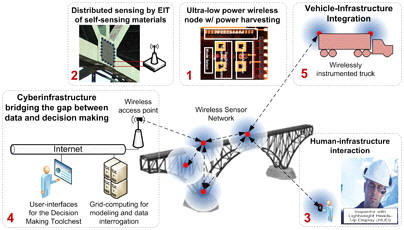Smart bridges under development with new grant
The monitoring system will collect data from surface and penetrating sensors, then wirelessly relay the information to an inspector on site or miles away.

 Enlarge
Enlarge
Faculty from EECS are working as part of an interdisciplinary University of Michigan College of Engineering team to develop smart bridges that can thoroughly discuss their health with bridge inspectors. The project, led by Professor Jerry Lynch of the Department of Civil and Environmental Engineering (CEE) and EECS, is developing a full range of interlocking technologies that will together sense and collect bridge status data and make it available to inspectors.
The monitoring system is envisioned to collect data from several different types of surface and penetrating sensors that detect cracks, corrosion and other signs of weakness. The system would also measure the effects of heavy trucks on bridges, which is currently impossible. Through enhanced antennas and the Internet, the system would wirelessly relay the information it gathers to an inspector on site or in an office miles away.
The EECS Team

 Enlarge
Enlarge
Mike Flynn and Dennis Sylvester will be developing low cost, compact, power- efficient, wireless sensing nodes that will be able to sense the state of the infrastructure, and then communicate that information wirelessly. Low cost is critical and a key goal is to reduce manufacturing cost so that the nodes can be pervasive throughout the structure.
Dennis Sylvester will focus his expertise in ultra-low power CMOS design to design an extremely low power microprocessor, on-chip temperature and other sensors, and efficient power management circuits that will enable orders of magnitude reductions in node volume and power consumption over competing approaches. Building on his work with the Phoenix processor, this lower power in turn enables exciting new power harvesting schemes to be used, creating a very low-cost solution with decades-long service lifetime.
Mingyan Liu will lead the effort in the networking component of the project by designing the structural monitoring sensor network both for distributed data collection, and as a smart distributed computing fabric so as to greatly enhance its energy efficiency. This will be done through the joint design of network communication and computation algorithms, while taking into account special features of structural health monitoring.
Amir Mortazawi and Khalil Najafi will focus on techniques for energy scavaging. Mortazawi brings electromagnetic energy scavenging to the project, harvesting energy from the radio frequency (RF) broadcast spectrum, and from much larger quantities from radiation sources like IEEE 802.11 (WiFi) or IEEE 802.15.4 (Zigbee) access points. Najafi will develop a novel frequency up-converting scheme to scavenge energy from low-frequency vibrations present on bridges and other physical structures. This approach will convert the low frequency vibrations through a MEMS structure to high frequency vibrations that are then efficiently converted to electrical power using electromagnetic or piezoelectric techniques, and used by the electronics and sensors.
Atul Prakash will be developing methods of providing robust and secure communication between the distributed low-power wireless sensors installed on the bridges, mobile data vehicles, and data servers (jointly with research scientist Ralph Robinson of the U-M Transportation Research Institute). He will also be investigating, jointly with CEE Professor Vineet Kamat, techniques for helping engineers to visualize the health of a bridge in the field on head-mounted displays and computers, by leveraging knowledge about their spatial location relative to the bridge.
An Interdisciplinary Approach that Serves an Interconnected World
This $19-million project is an exciting and instructive example of how EECS is making significant impact on large-scale technical and societal challenges through interdisciplinary research and development. The smart bridge project brings together 14 researchers from within the College of Engineering and the U-M Transportation Research Institute. In addition, engineers at five private firms in New York, California, and Michigan are key team members.
The project is funded by nearly $9 million from the National Institute of Standards and Technology’s (NIST) Technology Innovation Program (TIP). The remaining funding comes from cost-sharing among the entities involved and the Michigan Department of Transportation. MDOT has offered unfettered access to state bridges to serve as high-visibility test-beds showcasing the project technology.
 MENU
MENU 
